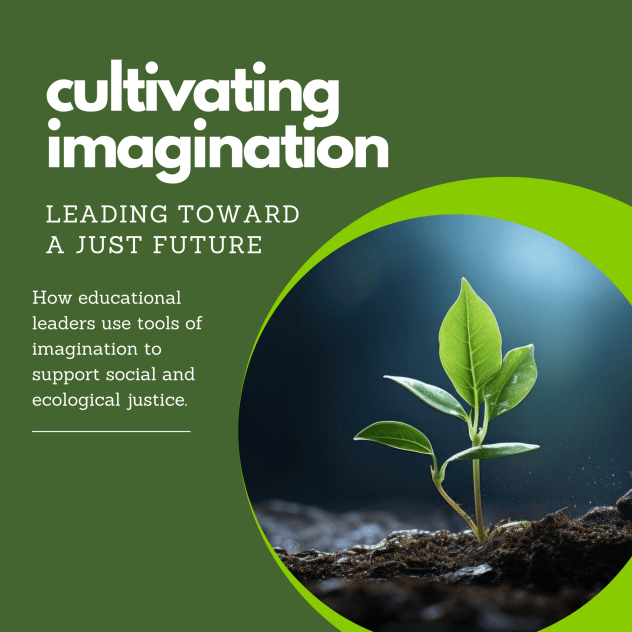by Cari Zall, Clinical Assistant Professor, Lewis & Clark Graduate School of Education & Counseling, Secondary MAT Program
Note: This blog is in response to Episode 3 of the Cultivating Imagination podcast.
As a novice teacher 20 years ago, I entered my high school classroom with the intention and hope of guiding young minds in growing their imaginations so they could feel agency upon the world around them. It did not take long for me to realize that public high schools were not designed to engender any sense of imagination in students. The crush of expectations on teachers and students in modern classrooms tends to outweigh any bubbles of imagination that might naturally emerge when children and young people are given the space for their minds to roam. Today’s classroom is dominated by accountability tasks, assessments, behavioral discipline, and races to meet benchmarks. Conversations about imagination, much less the practice of imagination, tend to disappear by the middle school grades, if they ever happen at all.
It is within this stark environment that we expect to grow children into adults who think creatively and critically. Yet we ignore the habits the system expects of them: hinging their self-worth on a letter grade, competition for scarce resources of scholarships and college funding, and navigating a world where they feel next to no sense of belonging. How can we, as educators and leaders in the classroom and in schools, shift this reality so that there is space and time for imagination in our students’ developing minds?
Care as a foundation for Imagination
Considering the power of imagination and how we might generate it as educators, the question that bubbles up for me as a teacher educator is how do we go beyond preparing someone to simply enter the field of teaching, but how do we prepare them to sustain themselves as an educator of humans? What always comes back to me is that we must be in the habit of recognizing that we are humans who teach, and we are teaching other humans. And just because they are young does not mean they are not fully human. So it is our responsibility to model for them and guide them in practices of generosity and openness. An ethic of care is the primary way I connect my desire to engender imaginative practices in my classroom and the humanness of my students.
As I regularly remind my teacher candidates, it is not the content they teach but how they teach that will make the difference in their students’ lives. Building an ethic of care into their practice is a way to develop culturally responsive habits that will give their students a strong sense of belonging. That belonging will open pathways in their minds that allow them to let go of the anxiety of the unexpected and be free to think beyond the rote topics they’ve managed their entire school careers. As Nel Noddings (1984) taught us, care is a set of relational practices that build a human community around empowerment, culture, growth mindset, and the protection of each other in a reciprocal process. If teacher education programs focused on developing these practices in novice teachers, then they would enter their classrooms ready to build relationships and communities, and the content areas would come second to that.
Within that relational space, the carer (the teacher) is able to take the time to not only practice but also model and teach with what John Seely Brown (Hurley, 2024) calls generous listening. That broadness of acceptance and that space where students can break away from the boundaries of the designed content of school only happens when they feel a sense of safety and belonging. A safe classroom, then, is not where everyone is coddled, but rather it is a space where students are not afraid to be brave, to dream and imagine, and then act creatively upon their imaginative ideas. As I often tell my teacher candidates, we must see to Maslow’s hierarchy of needs long before we tackle Bloom’s hierarchy of learning. The most basic needs of our very human students are at the essence of who they are and if those needs are not met, then the possibility they can flourish in an imaginative space is very minimal. Teaching based on an ethic of care seeks to meet those needs first, and then to carry that relationship of co-belonging into the academic space.
Generative Imagination as Courage
We often talk about imaginative leadership or generative conversations in the context of adults who are learning to be creative within their workspace. Indeed, folks like John Seely Brown and Ann Pendleton-Julian (Hurley, 2024) have changed the field with their work amongst those adults. I also find myself in professional development workshops with veteran teachers employing Brown’s “badger” tactic of trying to dislodge them from their traditional habits of thinking. So it is strange how we do this work with adults and forget to question how it is they lost that imaginative habit in the first place. In all likelihood, school choked it out of them. So here I am, a teacher educator, complicit in sending novice educators into a field that is built to excise any sense of creativity and bravery out of kids so that they will fall in line with the program and get through the system so our society can continue its status quo function. How we approach teacher education must then include that reality. Our work with novice teachers must follow Ann Pendleton-Julian’s call to not merely think outside the box, but to blow the box open and then add some sci-fi to its remnants. Kids rarely get the chance to do that in school, and that is because we don’t emphasize it in our leadership of new teachers.
In a world where all the information we need about academic content is available at the touch of a phone screen, what if the space in our classroom could become powerful and generative spaces of student voice? And why not make teacher education itself a model of these practices?
So now we come to our true calling as educators. We must be the ones who purposefully and intentionally build into our classrooms the time and space for kids to practice using their imagination. Not to simply be creative, but to truly imagine: worlds in which they have power, worlds where they experience justice, and worlds in which they can easily consider perspectives far different from their own. We can do that through classroom practices such as role plays and simulations, through creative writing and community exploration, and by constructing opportunities for play. We know that those methods work for purposes of engagement and student voice. Why not see them as avenues to imaginative practices? Why not engage students in these strategies, not with the purpose of accomplishing any sort of academic ends, but rather with the intention that they learn to listen generously to each other? In a world where all the information we need about academic content is available at the touch of a phone screen, what if the space in our classroom could become powerful and generative spaces of student voice? And why not make teacher education itself a model of these practices?
None of this, however, can happen, without a foundation of care. No student (or student teacher) can fully let themselves slide into imaginative worlds of problem-solving, exploration, world-building if they do not feel secure enough to be brave and have a sense of belonging that secures their ideas as legitimate. It is in that space that learning finds joy. As Gholdy Muhammad (2023) teaches us, “possibility is joy” – and we can’t ever grasp true possibility without the freedom to imagine. THAT is our work as teacher leaders. Creating those spaces first, and then dusting off the programmed status quo in education and lighting it on fire with our students’ human possibility. Finding and exercising the joy. That is how we sustain ourselves as educators.
References
Hurley, S. (Host). (2024). Cultivating Imagination Podcast, Episode 3: “Knitting Together Serendipitous Connections: On Imagination and World-Building with Ann Pendleton-Jullian and John Seely Brown.” https://cultivateimagination.ca/podcast/
Muhammad, G. (2023). Unearthing Joy. NY: Scholastic Professional.
Noddings, N. (1984). Caring: a relational approach to ethics and moral education. University of California Press.
Hear more from our leaders in the Cultivating Imagination podcast series.



